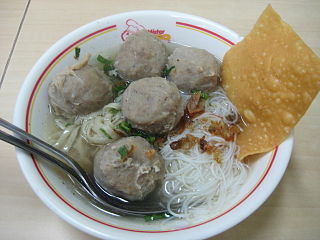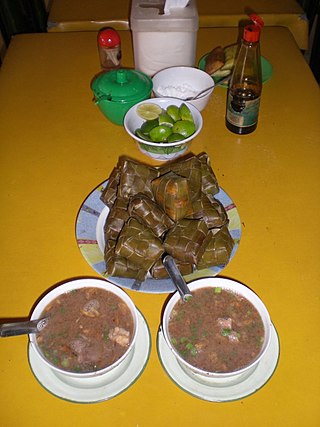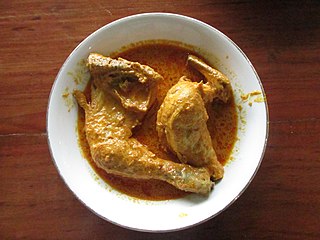
Satay, or sate in Indonesian spelling, is a Southeast Asian form of kebab made from seasoned, skewered and barbecued meat, served with a sauce.

Indonesian cuisine is a collection of various regional culinary traditions that formed in the archipelagic nation of Indonesia. There are a wide variety of recipes and cuisines in part because Indonesia is composed of approximately 6,000 populated islands of the total 17,508 in the world's largest archipelago, with more than 1,300 ethnic groups.

Otak-otak is a Southeast Asian fish cake made of ground fish mixed with spices and wrapped in leaf parcels. Otak-otak is traditionally served steamed or grilled, encased within the leaf parcel it is cooked in, and can be eaten solely as a snack or with steamed rice as part of a meal.

Nasi goreng is a Southeast Asian fried rice dish, usually cooked with pieces of meat and vegetables. One of Indonesia's national dishes, it is also eaten in Malay-speaking communities in countries such as Malaysia, Singapore and Brunei, and has gained popularity in Sri Lanka through migrations from the Indonesian Archipelago, in countries like Suriname via Indonesian immigrant communities, and in the Netherlands through its colonial ties with Indonesia. Nasi goreng is distinguished from other Asian fried rice preparations by its distinct smoky aroma, and caramelised yet savoury undertones of flavour. There is no single defined recipe for nasi goreng, and its composition and preparation varies greatly from household to household.

Bakso or baso is an Indonesian meatball, or a meat paste made from beef surimi. Its texture is similar to the Chinese beef ball, fish ball, or pork ball. The word bakso may refer to a single meatball or the complete dish of meatball soup. Mie bakso refers to bakso served with yellow noodles and rice vermicelli, while bakso kuah refers to bakso soup served without noodles.

Lontong is an Indonesian dish made of compressed rice cake in the form of a cylinder wrapped inside a banana leaf, commonly found in Indonesia, Malaysia, and Singapore. Rice is rolled inside a banana leaf and boiled, then cut into small cakes as a staple food replacement for steamed rice. The texture is similar to that of ketupat, with the difference being that the ketupat container is made from woven janur fronds, while lontong uses banana leaf instead.

Sundanese cuisine is the cuisine of the Sundanese people of Western Java, and Banten, Indonesia. It is one of the most popular foods in Indonesia. Sundanese food is characterised by its freshness; the famous lalab eaten with sambal and also karedok demonstrate the Sundanese fondness for fresh raw vegetables. Unlike the rich and spicy taste, infused with coconut milk and curry of Minangkabau cuisine, the Sundanese cuisine displays the simple and clear taste; ranged from savoury salty, fresh sourness, mild sweetness, to hot and spicy.

Coto Makassar or Coto Mangkasara (Makassarese), is an Indonesian traditional soup originating from Makassar, South Sulawesi. It is a variant of soto, traditionally made with beef, offal stew with seasoned broth made from ground peanuts and spices. The main ingredient of this soup is beef, and it can be mixed with innards, such as intestine, liver, lungs, heart, tripe, or cow brain.

Konro is an Indonesian rib soup originating with the Makassarese people of South Sulawesi. Usually this soup was made with ribs, such as spareribs or beef as main ingredient. The soup is brown-black in color and eaten either with burasa or ketupat cut into bite-size pieces or rice. The spicy and strong-tasting soup is made from a mixture of rich spices, which includes coriander, keluwak ; a fruit that gives it its blackish color, also small amount of nutmeg, turmeric, galangal, cinnamon, tamarind, lemongrass, clove, and salam.

Pallubasa is a traditional dish from Makassar, South Sulawesi, Indonesia. It is similar to coto makassar; however, while both are primarily made from offal and/or meat of cattle or buffalo, the meat for pallubasa is cooked longer, and served with a creamy santan and sautéed grated coconut broth in a bowl. Pallubasa may be served with a raw egg to make the broth even creamier, and lime juice to add zest to the broth. Unlike coto makassar, which is eaten with ketupat, pallubasa is eaten with a plate of white rice. It was also eaten with burasa in the past.

Soto is a traditional Indonesian soup mainly composed of broth, meat, and vegetables. Many traditional soups are called soto, whereas foreign and Western influenced soups are called sop.

Sambal is an Indonesian chili sauce or paste, typically made from a mixture of a variety of chilli peppers with secondary ingredients such as shrimp paste, garlic, ginger, shallot, scallion, palm sugar, and lime juice. Sambal is an Indonesian loanword of Javanese origin. It originated from the culinary traditions of Indonesia and is also an integral part of the cuisines of Singapore, Malaysia, Brunei, and Sri Lanka. It has also spread through overseas Indonesian populations to the Netherlands and Suriname.

Gulai is a class of spicy and rich stew commonly found in Malay Archipelago. The main ingredients of the dish are usually poultry, goat meat, beef, mutton, various kinds of offal, fish, and seafood, as well as vegetables such as cassava leaves, unripe jackfruit, and banana stem.

Palembangese cuisine is the cuisine of the Palembangese people of the city of Palembang in the South Sumatra province of Indonesia. It is the second most well-known cuisine from Sumatra after Padang.

Makassarese cuisine is the cuisine of Makassarese people of Makassar in the South Sulawesi province of Indonesia.

Indian Indonesian cuisine is characterized by the mixture of Indian cuisine with local Indonesian-style. This cuisine consists of adaptations of authentic dishes from India, as well as original creations inspired by the diverse food culture of Indonesia. Indian influence can be observed in Indonesia as early as the 4th century. Following the spread of Islam to Indonesia and trading, Muslim Indian as well as Arab influences made their way into Indonesian cuisine. Examples include Indian biryani, murtabak, curry and paratha that influenced Acehnese, Minangkabau, Malay, Palembangese, Betawi and Javanese cuisine.

Indonesian noodles are a significant aspect of Indonesian cuisine which is itself very diverse. Indonesian cuisine recognizes many types of noodles, with each region of the country often developing its own distinct recipes.

Nasi gandul or in Javanese sega gandhul is a rice dish served in rich, sweet, savoury and spicy beef soup, specialty of Pati Regency, Central Java, Indonesia. Nasi gandul consists of steamed rice topped with slices of beef served in spicy soup with savoury flavour in golden-brownish colour. Nasi gandul is somewhat quite similar to other Indonesian dishes; beef semur, tongseng and Javanese gulai.


















